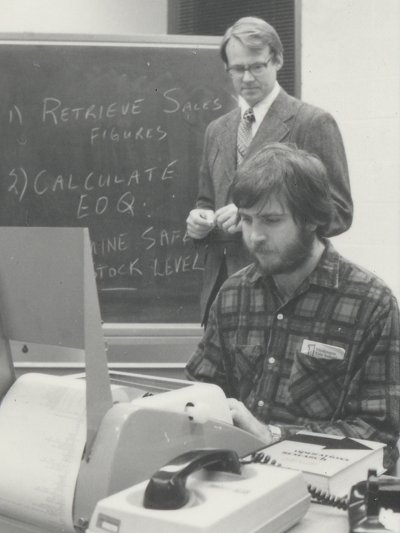| The Teletype by Dyah Apsari
A teletype (teleprinter, telewriter, or TTY) is a now largely obsolete electro-mechanical typewriter which can be used to communicate typed messages from point to point through a simple electrical communications channel, often just a pair of wires.
It is originally a 'hard copy terminal' that printed text slowly in capital letters on rolls of paper. Teletypes were made by Teletype Corporation. When DEC introduced visual display terminals these could operate in Teletype mode, like a 'glass typewriter'. Many communications programs still include a TTY mode to provide the simplest level of communication with a remote computer. This machine was still used until the 1960s or so by the news wire services. A specially-designed telegraph typewriter was used to send stock exchange information over telegraph wires the ticker machines. Some radio stations still use a recording of the sound of one of these machines as background during news broadcasts. These teletypewriters are also still in use by the deaf for typed communications over the telephone, usually called a TDD or TTY.
The teleprinter evolved through a series of inventions by a number of engineers, including Royal E. House, David E. Hughes, Edward Kleinschmidt, Charles Krum and Emile Baudot. A predecessor to the teleprinter, the stock ticker machine, was used as early as the 1870s as a method of displaying text transmitted over wires. The most modern form of these devices is fully electronic and uses a screen instead of a printer.
- Sources:
- History of Telewriter Development by R.A Nelson
- Teletype Machines
- Teleprinter
|
The Acoustic Coupler by Tim Bax
An acoustic coupler is a device couples electric signals-usually into and out of a telephone network. This link is achieved through sound, not a direct electrical connection. Back in the 1960's it was illegal to make an electrical connection to the telephone network. During that time, acoustic couplers were used to connect modems to the telephone network.
The way an acoustic coupler works is relatively simple. A regular telephone handset is placed in a cradle that is designed with rubber seals that fit snuggly around the microphone and earpiece of the handset. The microphone part of the handset acts as a loudspeaker, and a microphone in the earpiece picks up sounds form the loudspeaker. This is how signals were passed in either direction.
The first device used for this type of connection was the Acoustic Data Coupler 300 Modem, which had a speed of 300 bits per second (bps). Today 28,800 bps is considered an extremely slow connection, so you can imagine how slow 300 bps would have been. Eventually, the telephone industry was deregulated and it became legal to electrically connect to the telephone network. When this happened acoustic couplers started becoming rare. However, they are still used even today when people travel to countries where it is still illegal to electronically connect to the telephone network or when such a connection is not possible or impractical.
Interestingly enough, acoustic couplers are used today to connect computers to the Internet via payphones. Someone with a laptop can park outside a payphone and put the payphone's handset on their coupler and check their email from the road. However with wireless technology on the rise, it looks like the acoustic coupler's days are numbered. It will become even more rare than it already is!
|

